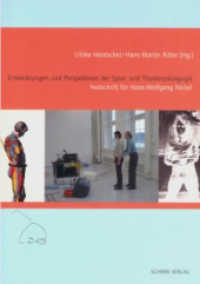- ホーム
- > 洋書
- > 英文書
- > Architecture
基本説明
New in paperback. Hardcover was published in 1983 and is out of print. Dr Whyte suggests that many of the roots of modern architecture were mystical and irrational, and were concerned less with function and purpose and more with millenarian dreams of the a society which might be achieved through the meditation of the architecture. The author also suggests that there were political reasons behind this type of architecture and why it failed to achieve its aim of improving the physical and social condition of society.
Full Description
Bruno Taut was the leading architectural theorist in Germany during the years 1914-1920. The architectural and social premises which he developed in this seminal period were to be of paramount importance in the subsequent development of modern architecture in Germany in the 1920s. The German example, in turn, was to become a model for the international modern movement. Whereas the history of the modern movement in architecture has generally been written in terms of functionalism, and the availability of materials and technology, Dr Whyte suggests that many of the roots of modern architecture were mystical and irrational, and were concerned less with function and purpose and more with millenarian dreams of the a society which might be achieved through the meditation of the architecture. The author also suggests that there were political reasons behind this type of architecture and why it failed to achieve its aim of improving the physical and social condition of society.
Contents
List of illustrations; Preface; Introduction; Part I. The Roots of Activism: 1. Reformism and Expressionism; 2. Bruno Taut: 1900-1914; Part II. 1914-1918: The Foundations of Activist Architecture: 3. Pacifism; 4. Regeneration; 5. Chiliastic expectations - the Gemeinschaft; 6. Geist and Volk; 7. The role of the activist; 8. The rationalism of intuition; 9. The new city and the resonance of Geist and Volk; Part III. November 1918-April 1919. Activism and Political Engagement: 11. The Politischer Rat geistiger Arbeiter and the Arbeitrat für Kunst; 12. The politics of decentralisation; 13. The AFK, December 1918-April 1919; Part IV. April 1919-December 1920: 14. The AFK under Walter Gropius; 15. The Ausstellung für unbekannte Architekten; 16. Taut and the Proletkult; 17. Taut's literary activity in the summer of 1919; 18. The Bund für proletarische Kultur; 19. the Werkbund conference: September 1919; 20. Autumn and winter 1919: unrealised projects; 21. The Gläserne Kett; 22. Taut and the theatre; 23. The end of an avant-garde; Conclusion; Appendices; Notes; Bibliography; Sources of illustrations; Index.








